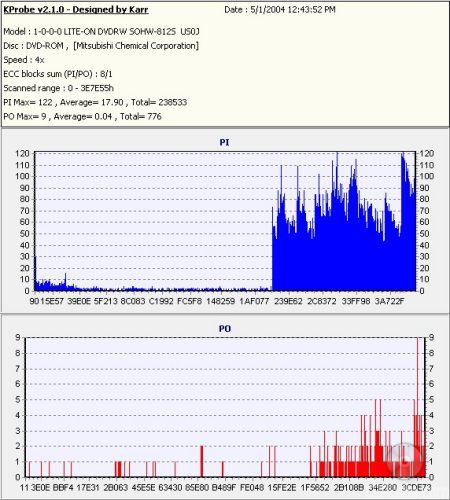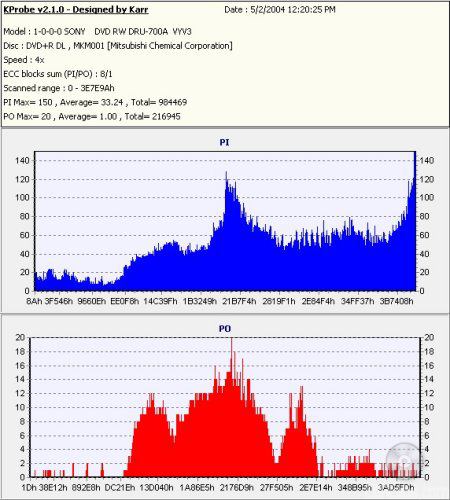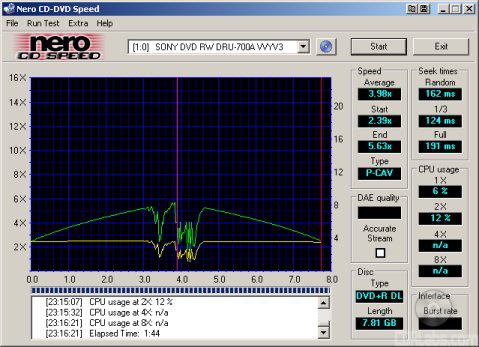Right away, I ran into a problem when testing the writing quality of double layer DVD+R discs. Normally, when testing with KProbe I use two Lite-On DVD writers, the LDW-401S and the LDW-811S. Unfortunately, neither drive was able to recognize Mitsubishi's DVD+R DL media. After talking to Sony, I was able to get a little more information on this:
"Other burners, that check disc ID codes, won't recognize a DVD+R DL disc because they don't have the DVD+R DL disc ID code in their firmware. Even when a disc has been recorded and finalized, other burners still look for a media code and generally will eject a disc without one. Sony has recognized this and will be making a firmware upgrade available in early May that allows Sony's 510/530 customers (500 most likely as well) to read/play a finalized DVD+R DL disc. Sony can't say how other manufacturers will handle this, however, we don't expect that many users will be playing back discs in other burners."
Going by Sony's comments, it sounds like double layer DVD+R discs aren't as compatible as many have thought. To get around this problem, I tested the writing quality using Lite-On's new 8x DVD±RW, the SOHW-812S, and the Sony DRU-700A. Neither drive had problems recognizing Mitsubishi's DVD+R DL media.
The test results varied a lot. Not only from disc to disc or from drive to drive, but from one test run to another. The results shown below are a good example of what we saw on average.
With the SOHW-812S, the number of PI and PO errors stays very low until it hits the second layer. At this point, the errors jump up considerably. While the number of PI errors is within acceptable limits, there are a few cases where the PO errors are a little higher than they should be (> 4). The results aren't nearly as good with Sony's new drive. While still acceptable, the number of PI errors is fairly high throughout the entire disc. The number of PO errors is also much higher, in some cases jumping up as high as 20.
I also tried reading the discs using Nero CD-DVD Speed. In theory, if the number of PO errors is as high as indicated by the DRU-700A's KProbe results, both drives should have problems reading back the discs.
As you can see, both drives had their share of problems reading Mitsubishi's DVD+R DL discs. While I expected a few slow downs when reading the second layer, they also occurred during the first layer. This makes me think that the Sony's KProbe results are probably a little more accurate than the Lite-On's, at least with DVD+R DL media. Even then, without more double layer media and drives to test with, I'm not really prepared to put my money on one or the other quite yet. A lot more testing still needs to be done.
While the results shown here aren't exactly favorable, you need to keep in mind that our tests were run using a pre-production drive and early samples of Verbatim's DVD+R DL media. Hopefully the results will be much better when double layer DVD+R technology goes prime time later this year.
Conclusion:
So what you say? You're waiting for blue laser technology like Blu-Ray and HD-DVD? While these technologies offer capacity much greater than DVD+R DL, it's going to be a number of years before they become mainstream and even longer before the prices come down to semi-affordable levels. Right now, Sony's Blue-ray recorders (which are only available in Japan) will set you back more than $2500 with media running about $20 a disc. Even then, it's not clear which format will win out in the end. While Blu-ray has an early lead, the DVD Forum's HD-DVD format is quickly gaining ground. In a situation like this, early adopters might find themselves with the next "Betamax".
For now though, double layer DVD+R technology has a lot of potential. While far from being speedy, the extra capacity it offers will make it a big hit among consumers, especially those looking to backup, or archive, their movie collection. Even then, this new technology isn't without its growing pains. As we've shown you here, there are still some writing quality and compatibility issues that need to be worked out. Being able to store up to 8.5GB of data on one disc doesn't mean much if existing DVD-ROM drives and DVD players can't read it. Hopefully, drive and media manufacturers will spend the next few months improving these things.
I have not seen any concrete shipping dates yet, but word on the street is that we could see double layer DVD+R drives from companies like Lite-On and Sony as early as May. However, most manufacturers seem to be waiting until June or July to ship their drives. This is mostly due to the lack of DVD+R DL media. It's been reported that manufacturers like Mitsubishi have ramped up production, but it's going to be some time before their factories can match the demand. In the mean time, expect to pay a premium for DVD+R DL media. Current estimations range from $5 all the way up to $15 per disc. Of course, we won't know until they actually start hitting store shelves later this summer.
| Double Layer DVD+R Resources |
I want to say thank you to Rebecca S., Melissa D. and the good people at Sony for helping to make this article possible.





